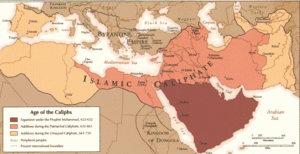Caliphate: Difference between revisions
imported>Minhaj Ahmed Khan Lodi No edit summary |
mNo edit summary |
||
| (19 intermediate revisions by 8 users not shown) | |||
| Line 1: | Line 1: | ||
A '''caliphate''' (from the [[Arabic]] '''خلافة''' or ''khilāfah''), is | {{Subpages}} | ||
A '''caliphate''' (from the [[Arabic]] '''خلافة''' or ''khilāfah''), is a form of government the Islamic that developed in the first half millennium after the life of [[Muhammad]]. The post of caliph comprises of the unity of [[Head of State]], [[head of government]], and [[head of religion]], and represents the political unity and leadership of the Muslim world. The literal meaning of caliph is 'successor', as in, successor to [[Muhammad]]'s political authority. | |||
[[Image:Age_of_the_Caliphs.gif|300px|thumb|The Caliphate, 622-750]] | [[Image:Age_of_the_Caliphs.gif|300px|thumb|The Caliphate, 622-750]] | ||
By the [[Sunni]] muslim view, he is ideally a member of the [[Quraysh]] [[tribe]] [[Election|elected]] democratically by the majority of the Muslim population. According to the [[Shi'a]], he is an [[Imam]] descended directly from the [[Ahl ul-Bayt]]. According to the [[Ibadi]] view, any Muslim who is just and righteous is fit to take the post. | |||
The | The post of caliph has been held by the democratically elected [[Rashidun]] caliphs, and by the [[Monarchy|monarchist]] caliphates, successively the [[Umayyad]]s, the [[Abbasid]]s, and the [[Ottoman]]s. In addition to these widely recognized caliphates, numerous local rulers assumed the title. The [[Fatimid]]s of Egypt, who were the Imams of the Ismaili subdivision of the Shia, also used the title of caliph. | ||
[[ | The [[Ottoman Empire|Ottoman]] caliphate was declared abolished by the Turkish Parliament in 1924 following [[Mustafa Kemal Atatürk|Mustafa Kemal]]'s revolution in [[Turkey]]. Soon afterwards the King of hijaz, as guardian of the holy places, declared himself caliph. He was recognized outside his own kingdom by a few mosques in Iraq and Transjordan, but he was soon deposed by the Saudis, abdicating in favour of his son, who in turn renounced his claims. In 1926, a semi-official international congress declared the caliphate suspended. Since then, there have been various attempts to re-establish the caliphate, [[Peace|peacefully]] and [[Violence|violently]]. For example, [[Hizb ul-Taheri]] seeks the peaceful re-establishment of the caliphate, while other groups seek to re-establish it by revolution. Currently, the closest generally recognized entity to the caliphate is the [[Organization of the Islamic Conference]]. In 2014 a group controlling substantial parts of Iraq and Syria proclaimed its leader Caliph, and he was also recognized in small areas of Libya and Nigeria. | ||
[[ | |||
[[ | The caliphate of the [[Ahmadiyya]] must be distinguished from the above, as these Caliphs are successors only of that group's founder, and do not claim to be successors of [[Muhammad]].[[Category:Suggestion Bot Tag]] | ||
[[ | |||
[[ | |||
[[ | |||
[[Category: | |||
Latest revision as of 06:00, 24 July 2024
A caliphate (from the Arabic خلافة or khilāfah), is a form of government the Islamic that developed in the first half millennium after the life of Muhammad. The post of caliph comprises of the unity of Head of State, head of government, and head of religion, and represents the political unity and leadership of the Muslim world. The literal meaning of caliph is 'successor', as in, successor to Muhammad's political authority.
By the Sunni muslim view, he is ideally a member of the Quraysh tribe elected democratically by the majority of the Muslim population. According to the Shi'a, he is an Imam descended directly from the Ahl ul-Bayt. According to the Ibadi view, any Muslim who is just and righteous is fit to take the post.
The post of caliph has been held by the democratically elected Rashidun caliphs, and by the monarchist caliphates, successively the Umayyads, the Abbasids, and the Ottomans. In addition to these widely recognized caliphates, numerous local rulers assumed the title. The Fatimids of Egypt, who were the Imams of the Ismaili subdivision of the Shia, also used the title of caliph.
The Ottoman caliphate was declared abolished by the Turkish Parliament in 1924 following Mustafa Kemal's revolution in Turkey. Soon afterwards the King of hijaz, as guardian of the holy places, declared himself caliph. He was recognized outside his own kingdom by a few mosques in Iraq and Transjordan, but he was soon deposed by the Saudis, abdicating in favour of his son, who in turn renounced his claims. In 1926, a semi-official international congress declared the caliphate suspended. Since then, there have been various attempts to re-establish the caliphate, peacefully and violently. For example, Hizb ul-Taheri seeks the peaceful re-establishment of the caliphate, while other groups seek to re-establish it by revolution. Currently, the closest generally recognized entity to the caliphate is the Organization of the Islamic Conference. In 2014 a group controlling substantial parts of Iraq and Syria proclaimed its leader Caliph, and he was also recognized in small areas of Libya and Nigeria.
The caliphate of the Ahmadiyya must be distinguished from the above, as these Caliphs are successors only of that group's founder, and do not claim to be successors of Muhammad.
